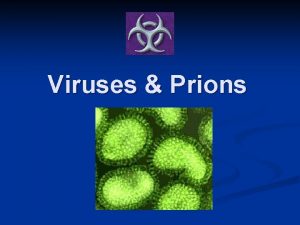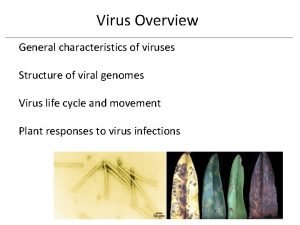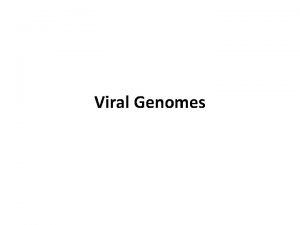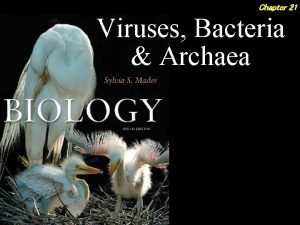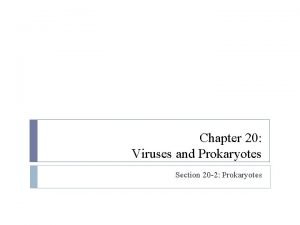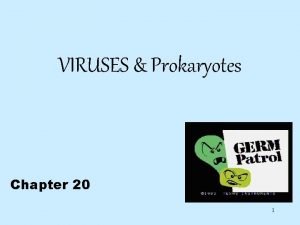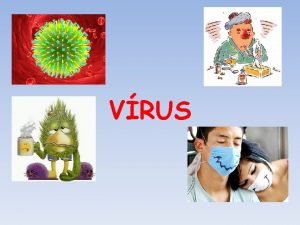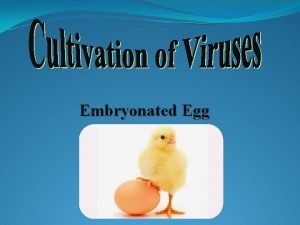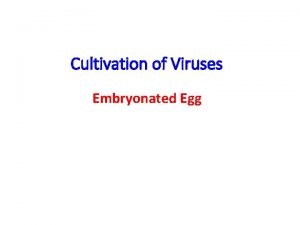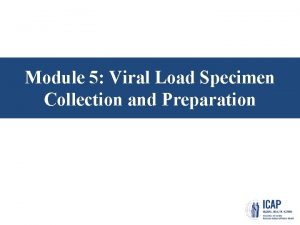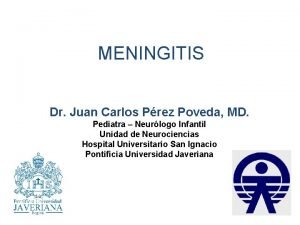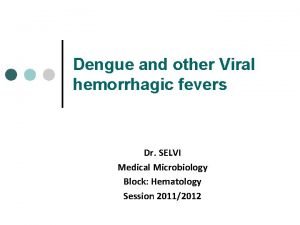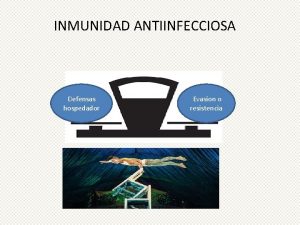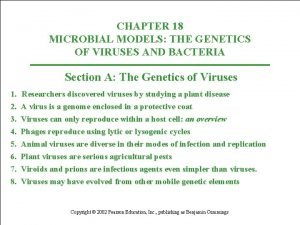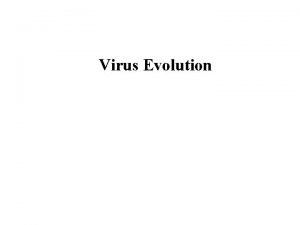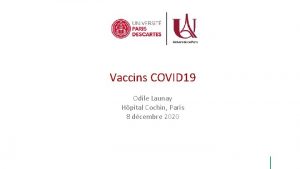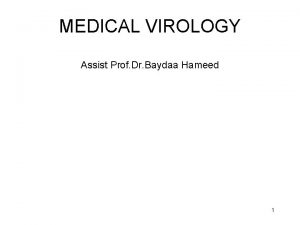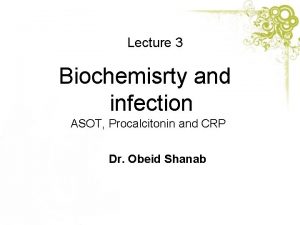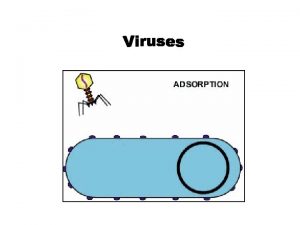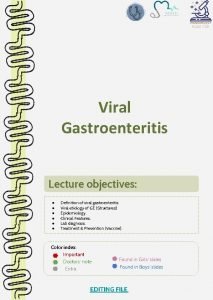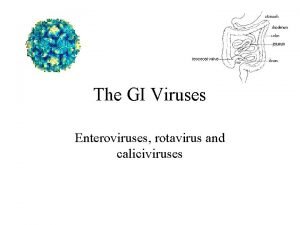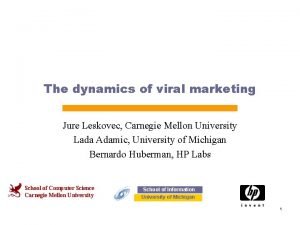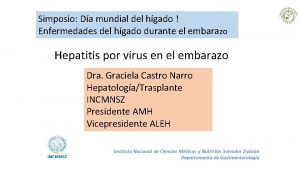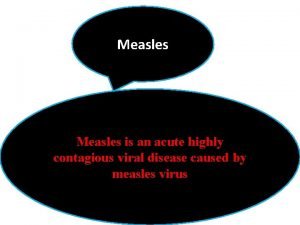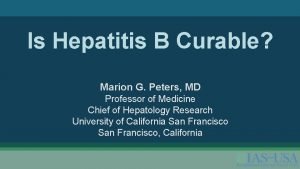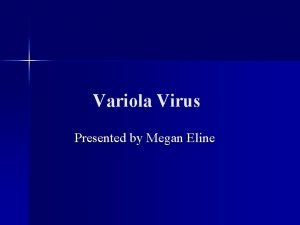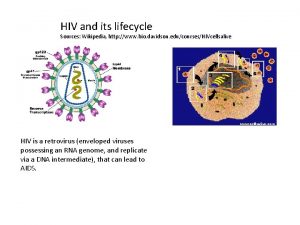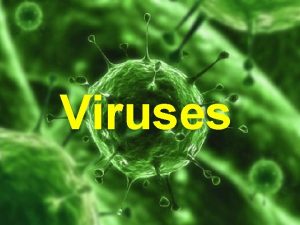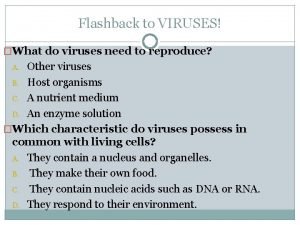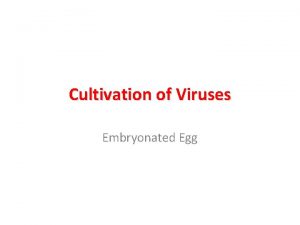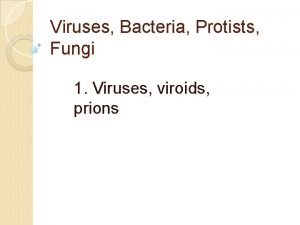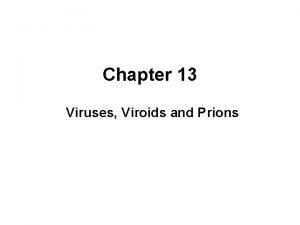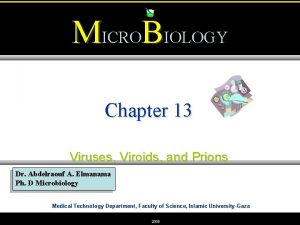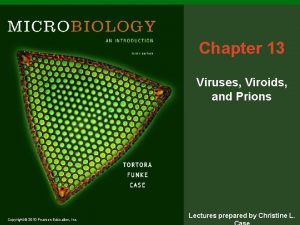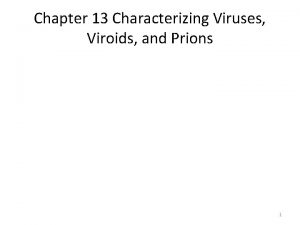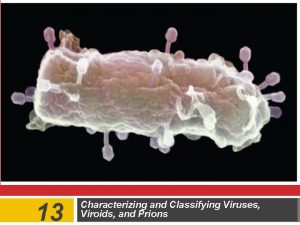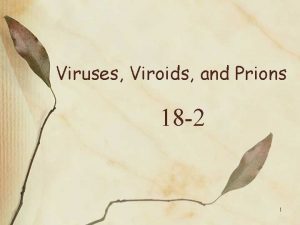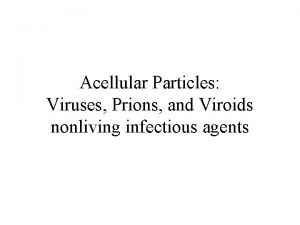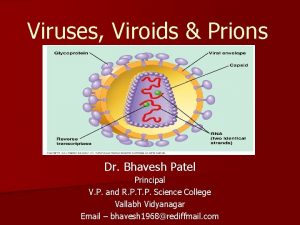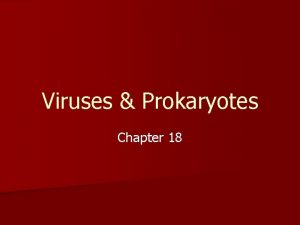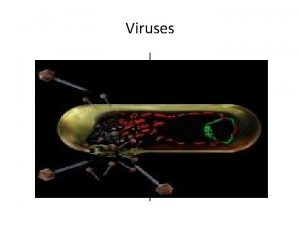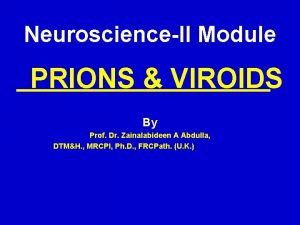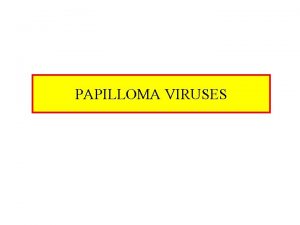Chapter 13 Viruses Viroids and Prions Viral Characteristics





















































- Slides: 53

Chapter 13: Viruses, Viroids, and Prions Viral Characteristics Viral Cultivation Viral Infections Viruses and Cancer Prions/ Viroids $100 $100 $200 $200 $300 $300 $400 $400 $500 $500 Bradley W. Christian, Mc. Lennan Community College © 2016 Pearson Education, Inc. FINAL ROUND

Topic 1: Viral Characteristics $100 Question Which of the following is TRUE regarding viruses? a. b. c. d. Virions contain both DNA and RNA. They multiply by binary fission. They are sensitive to antibiotics. They are not composed of cells. ANSWER © 2016 Pearson Education, Inc. BACK TO GAME

Topic 1: Viral Characteristics $100 Answer Which of the following is TRUE regarding viruses? a. b. c. d. Virions contain both DNA and RNA. They multiply by binary fission. They are sensitive to antibiotics. They are not composed of cells. © 2016 Pearson Education, Inc. BACK TO GAME

Topic 1: Viral Characteristics $200 Question Which of the following is NOT a morphological type of virus? a. b. c. d. helical polymorphic polyhedral enveloped ANSWER © 2016 Pearson Education, Inc. BACK TO GAME

Topic 1: Viral Characteristics $200 Answer Which of the following is NOT a morphological type of virus? a. b. c. d. helical polymorphic polyhedral enveloped © 2016 Pearson Education, Inc. BACK TO GAME

Topic 1: Viral Characteristics $300 Question Viruses that infect bacteria are called a. b. c. d. bacteriophages. prions. viroids. antisense viruses. ANSWER © 2016 Pearson Education, Inc. BACK TO GAME

Topic 1: Viral Characteristics $300 Answer Viruses that infect bacteria are called a. b. c. d. bacteriophages. prions. viroids. antisense viruses. © 2016 Pearson Education, Inc. BACK TO GAME

Topic 1: Viral Characteristics $400 Question The suffix –viridae is used for virus a. b. c. d. genus names. order names. phylum names. family names. ANSWER © 2016 Pearson Education, Inc. BACK TO GAME

Topic 1: Viral Characteristics $400 Answer The suffix –viridae is used for virus a. b. c. d. genus names. order names. phylum names. family names. © 2016 Pearson Education, Inc. BACK TO GAME

Topic 1: Viral Characteristics $500 Question Capsids are composed of protein subunits known as a. b. c. d. capsomeres. spikes. envelopes. tail fibers. ANSWER © 2016 Pearson Education, Inc. BACK TO GAME

Topic 1: Viral Characteristics $500 Answer Capsids are composed of protein subunits known as a. b. c. d. capsomeres. spikes. envelopes. tail fibers. © 2016 Pearson Education, Inc. BACK TO GAME

Topic 2: Viral Cultivation $100 Question What is/are the MOST common method(s) used to identify viruses? a. b. c. d. serological methods observation of cytopathic effects polymerase chain reaction (PCR) morphology ANSWER © 2016 Pearson Education, Inc. BACK TO GAME

Topic 2: Viral Cultivation $100 Answer What is/are the MOST common method(s) used to identify viruses? a. b. c. d. serological methods observation of cytopathic effects polymerase chain reaction (PCR) morphology © 2016 Pearson Education, Inc. BACK TO GAME

Topic 2: Viral Cultivation $200 Question ALL of the following can be used to culture animal viruses EXCEPT a. b. c. d. laboratory animals. cell culture. embryonated eggs. glucose broth. ANSWER © 2016 Pearson Education, Inc. BACK TO GAME

Topic 2: Viral Cultivation $200 Answer ALL of the following can be used to culture animal viruses EXCEPT a. b. c. d. laboratory animals. cell culture. embryonated eggs. glucose broth. © 2016 Pearson Education, Inc. BACK TO GAME

Topic 2: Viral Cultivation $300 Question Cell deteriorations due to viral infections are known as a. b. c. d. transformations. biosynthesis. cytopathic effects. plaques. ANSWER © 2016 Pearson Education, Inc. BACK TO GAME

Topic 2: Viral Cultivation $300 Answer Cell deteriorations due to viral infections are known as a. b. c. d. transformations. biosynthesis. cytopathic effects. plaques. © 2016 Pearson Education, Inc. BACK TO GAME

Topic 2: Viral Cultivation $400 Question Continuous cell lines a. b. c. d. die out after only a few generations. are sometimes called immortal cell lines. are grown in embryonated eggs. are derived from bacteria. ANSWER © 2016 Pearson Education, Inc. BACK TO GAME

Topic 2: Viral Cultivation $400 Answer Continuous cell lines a. b. c. d. die out after only a few generations. are sometimes called immortal cell lines. are grown in embryonated eggs. are derived from bacteria. © 2016 Pearson Education, Inc. BACK TO GAME

Topic 2: Viral Cultivation $500 Question The plaque method can be used to a. b. c. d. grow bacteriophages. grow animal viruses. genetically modify viruses. identify viral species. ANSWER © 2016 Pearson Education, Inc. BACK TO GAME

Topic 2: Viral Cultivation $500 Answer The plaque method can be used to a. b. c. d. grow bacteriophages. grow animal viruses. genetically modify viruses. identify viral species. © 2016 Pearson Education, Inc. BACK TO GAME

Topic 3: Viral Infections $100 Question Which of the following is an example of a persistent viral infection in humans? a. b. c. d. cold sore HIV/AIDS shingles influenza ANSWER © 2016 Pearson Education, Inc. BACK TO GAME

Topic 3: Viral Infections $100 Answer Which of the following is an example of a persistent viral infection in humans? a. b. c. d. cold sore HIV/AIDS shingles influenza © 2016 Pearson Education, Inc. BACK TO GAME

Topic 3: Viral Infections $200 Question Which of the following is an example of a latent viral infection in humans? a. b. c. d. measles HIV/AIDS shingles influenza ANSWER © 2016 Pearson Education, Inc. BACK TO GAME

Topic 3: Viral Infections $200 Answer Which of the following is an example of a latent viral infection in humans? a. b. c. d. measles HIV/AIDS shingles influenza © 2016 Pearson Education, Inc. BACK TO GAME

Topic 3: Viral Infections $300 Question The enzyme that uses viral RNA as a template to produce complementary double-stranded DNA is a. b. c. d. DNA polymerase. DNA ligase. RNA-dependent RNA polymerase. reverse transcriptase. ANSWER © 2016 Pearson Education, Inc. BACK TO GAME

Topic 3: Viral Infections $300 Answer The enzyme that uses viral RNA as a template to produce complementary double-stranded DNA is a. b. c. d. DNA polymerase. DNA ligase. RNA-dependent RNA polymerase. reverse transcriptase. © 2016 Pearson Education, Inc. BACK TO GAME

Topic 3: Viral Infections $400 Question Viruses that infect and lyse cancer cells are called a. b. c. d. oncogenic viruses. latent viruses. oncolytic viruses. lysogenic viruses. ANSWER © 2016 Pearson Education, Inc. BACK TO GAME

Topic 3: Viral Infections $400 Answer Viruses that infect and lyse cancer cells are called a. b. c. d. oncogenic viruses. latent viruses. oncolytic viruses. lysogenic viruses. © 2016 Pearson Education, Inc. BACK TO GAME

Topic 3: Viral Infections $500 Question Viruses capable of inducing tumors in animals are called a. b. c. d. oncogenic viruses. latent viruses. oncolytic viruses. lysogenic viruses. ANSWER © 2016 Pearson Education, Inc. BACK TO GAME

Topic 3: Viral Infections $500 Answer Viruses capable of inducing tumors in animals are called a. b. c. d. oncogenic viruses. latent viruses. oncolytic viruses. lysogenic viruses. © 2016 Pearson Education, Inc. BACK TO GAME

Topic 4: Viruses and Cancer $100 Question Cancer-causing alterations to cellular DNA affect parts of the genome called a. b. c. d. introns. oncogenes. exons. promoters. ANSWER © 2016 Pearson Education, Inc. BACK TO GAME

Topic 4: Viruses and Cancer $100 Answer Cancer-causing alterations to cellular DNA affect parts of the genome called a. b. c. d. introns. oncogenes. exons. promoters. © 2016 Pearson Education, Inc. BACK TO GAME

Topic 4: Viruses and Cancer $200 Question Sarcoma is a cancer of ____ tissue. a. b. c. d. nervous epithelial muscular connective ANSWER © 2016 Pearson Education, Inc. BACK TO GAME

Topic 4: Viruses and Cancer $200 Answer Sarcoma is a cancer of ____ tissue. a. b. c. d. nervous epithelial muscular connective © 2016 Pearson Education, Inc. BACK TO GAME

Topic 4: Viruses and Cancer $300 Question The ability of retroviruses to induce tumors is related to which enzyme? a. b. c. d. reverse transcriptase RNA polymerase DNA polymerase protease ANSWER © 2016 Pearson Education, Inc. BACK TO GAME

Topic 4: Viruses and Cancer $300 Answer The ability of retroviruses to induce tumors is related to which enzyme? a. b. c. d. reverse transcriptase RNA polymerase DNA polymerase protease © 2016 Pearson Education, Inc. BACK TO GAME

Topic 4: Viruses and Cancer $400 Question Which of the following is NOT an effect of transformation? a. T antigens appear in the nucleus of the cell. b. Cells lose their ability to divide. c. Cells tend to exhibit chromosomal abnormalities. d. Tumor-specific transplantation antigens appear on the cell surface. ANSWER © 2016 Pearson Education, Inc. BACK TO GAME

Topic 4: Viruses and Cancer $400 Answer Which of the following is NOT an effect of transformation? a. T antigens appear in the nucleus of the cell. b. Cells lose their ability to divide. c. Cells tend to exhibit chromosomal abnormalities. d. Tumor-specific transplantation antigens appear on the cell surface. © 2016 Pearson Education, Inc. BACK TO GAME

Topic 4: Viruses and Cancer $500 Question What percentage of cancers are known to be virus-induced? a. b. c. d. 10% 25% 50% 100% ANSWER © 2016 Pearson Education, Inc. BACK TO GAME

Topic 4: Viruses and Cancer $500 Answer What percentage of cancers are known to be virus-induced? a. b. c. d. 10% 25% 50% 100% © 2016 Pearson Education, Inc. BACK TO GAME

Topic 5: Prions/Viroids $100 Question A viroid is a a. b. c. d. provirus. naked, infectious piece of RNA. capsid without a nucleic acid. complete, infectious virus particle. ANSWER © 2016 Pearson Education, Inc. BACK TO GAME

Topic 5: Prions/Viroids $100 Answer A viroid is a a. b. c. d. provirus. naked, infectious piece of RNA. capsid without a nucleic acid. complete, infectious virus particle. © 2016 Pearson Education, Inc. BACK TO GAME

Topic 5: Prions/Viroids $200 Question Viroids infect a. b. c. d. animals. protozoans. plants. bacteria. ANSWER © 2016 Pearson Education, Inc. BACK TO GAME

Topic 5: Prions/Viroids $200 Answer Viroids infect a. b. c. d. animals. protozoans. plants. bacteria. © 2016 Pearson Education, Inc. BACK TO GAME

Topic 5: Prions/Viroids $300 Question Scrapie is an example of a ____ disease found in sheep and caused by a prion. a. b. c. d. neurological gastrointestinal respiratory cardiovascular ANSWER © 2016 Pearson Education, Inc. BACK TO GAME

Topic 5: Prions/Viroids $300 Answer Scrapie is an example of a ____ disease found in sheep and caused by a prion. a. b. c. d. neurological gastrointestinal respiratory cardiovascular © 2016 Pearson Education, Inc. BACK TO GAME

Topic 5: Prions/Viroids $400 Question Prion diseases can be acquired via ALL of the following EXCEPT a. b. c. d. ingestion. inhalation. contaminated surgical instruments. transplanted nerve tissue. ANSWER © 2016 Pearson Education, Inc. BACK TO GAME

Topic 5: Prions/Viroids $400 Answer Prion diseases can be acquired via ALL of the following EXCEPT a. b. c. d. ingestion. inhalation. contaminated surgical instruments. transplanted nerve tissue. © 2016 Pearson Education, Inc. BACK TO GAME

Topic 5: Prions/Viroids $500 Question It is hypothesized that viroids evolved from a. b. c. d. viruses. exons. introns. prions. ANSWER © 2016 Pearson Education, Inc. BACK TO GAME

Topic 5: Prions/Viroids $500 Answer It is hypothesized that viroids evolved from a. b. c. d. viruses. exons. introns. prions. © 2016 Pearson Education, Inc. BACK TO GAME

FINAL ROUND Question Which type of viral nucleic acid functions as m. RNA? a. b. c. d. RNA, double-stranded RNA, – strand RNA, + strand RNA, reverse transcriptase ANSWER © 2016 Pearson Education, Inc. BACK TO GAME

FINAL ROUND Answer Which type of viral nucleic acid functions as m. RNA? a. b. c. d. RNA, double-stranded RNA, – strand RNA, + strand RNA, reverse transcriptase © 2016 Pearson Education, Inc. BACK TO GAME
 Study guide chapter 18 section 1 bacteria
Study guide chapter 18 section 1 bacteria Https://m..com/watch?v=nqecciuc7jy
Https://m..com/watch?v=nqecciuc7jy Lysogenic cycle animation
Lysogenic cycle animation Are prions alive
Are prions alive Mad cow disease in humans
Mad cow disease in humans Domain bacteria characteristics
Domain bacteria characteristics Bacteriophage characteristics
Bacteriophage characteristics General characteristics of viruses
General characteristics of viruses Egrette - chapter 21
Egrette - chapter 21 Nonliving particle that replicates inside a living cell
Nonliving particle that replicates inside a living cell Bacteria and viruses chapter 7 lesson 1 answer key
Bacteria and viruses chapter 7 lesson 1 answer key Chapter 20 viruses and prokaryotes
Chapter 20 viruses and prokaryotes Section 24-1 viral structure and replication
Section 24-1 viral structure and replication Section 19-3 diseases caused by bacteria and viruses
Section 19-3 diseases caused by bacteria and viruses Section 1 studying viruses and prokaryotes
Section 1 studying viruses and prokaryotes Viral induced wheeze vs asthma
Viral induced wheeze vs asthma Vrus
Vrus Viral replikasyon basamakları
Viral replikasyon basamakları Viral inoculation in embryonated egg
Viral inoculation in embryonated egg Viral inoculation in embryonated egg
Viral inoculation in embryonated egg Virus cultivation in embryonated eggs
Virus cultivation in embryonated eggs Spasmodic croup vs viral croup
Spasmodic croup vs viral croup Variola varicela
Variola varicela Decapsidação
Decapsidação Hemolyzed serum sample
Hemolyzed serum sample Que causa la meningitis
Que causa la meningitis Causes of viral hemorrhagic fever
Causes of viral hemorrhagic fever Inmunidad
Inmunidad Capsid capsomere
Capsid capsomere Viral
Viral Viral recombination
Viral recombination Vaccins à vecteur viral
Vaccins à vecteur viral Viral receptors
Viral receptors Procalcitonin
Procalcitonin Equine viral rhinopneumonitis
Equine viral rhinopneumonitis Viral dna
Viral dna Dha mcq
Dha mcq Viral entry
Viral entry The dynamics of viral marketing
The dynamics of viral marketing Hgado
Hgado Csf findings in meningitis table
Csf findings in meningitis table Viral arthritis
Viral arthritis An acute highly contagious viral disease
An acute highly contagious viral disease Viral life cycle
Viral life cycle Infinitive viral infection
Infinitive viral infection Viral shedding
Viral shedding Eline's viral
Eline's viral Andrew lippman mit
Andrew lippman mit Hiv life cycle wikipedia
Hiv life cycle wikipedia Vacinas subcutânea
Vacinas subcutânea Why are viruses considered nonliving?
Why are viruses considered nonliving? Viruses
Viruses Lysogenic viruses do not
Lysogenic viruses do not Cultivation of viruses
Cultivation of viruses



